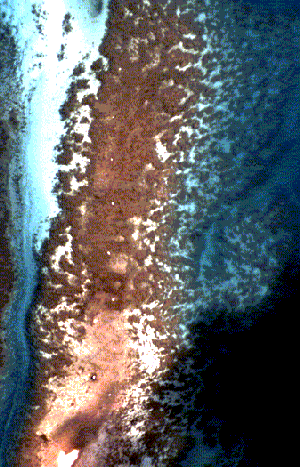|
|
Staff involved:Pete Mumby, Chris Clark (University of Sheffield), Al Edwards, John Chisholm (Monaco), Jean Jaubert (Monaco), John Hedley (PhD Student)Funding:NERC, Royal Society, University of Newcastle
CASI image of Motu Nuhi Nuhi, Rangiroa Atoll |
Coral reef remote sensingProjectIn the late 1990s, an international agenda began to develop high-resolution remote sensing of coral reefs with the United States and Australia both investing in new sensors and technology. In 1999, there were 4 international workshops on this topic alone. Interest in reef remote sensing stems from the clarity of many tropical seas which permit collection of spatial data over large spatial scales, and the pressing need to monitor the change in benthic community structure resulting from environmental stress including coral bleaching and nutrification. Since most deleterious processes on reefs result in coral mortality and macroalgal overgrowth, the principal focus for remote sensing is the measurement of live coral, dead coral, and macroalgal cover. This project focuses on the mapping of coral mortality states, coral cover, and algal cover using remote sensing. In situ spectra are being analysed together with hyperspectral and multispectral CASI data. Radiative transfer modelling is also being conducted. SignificanceImprove the monitoring of coral cover and gain a better understanding of the limitations of remote sensing for reef science. References
|
